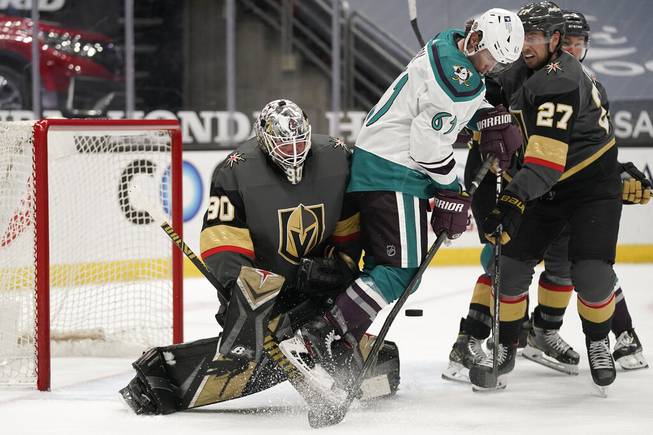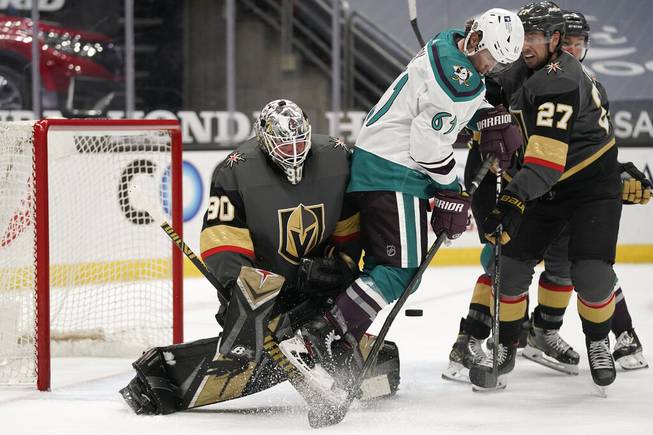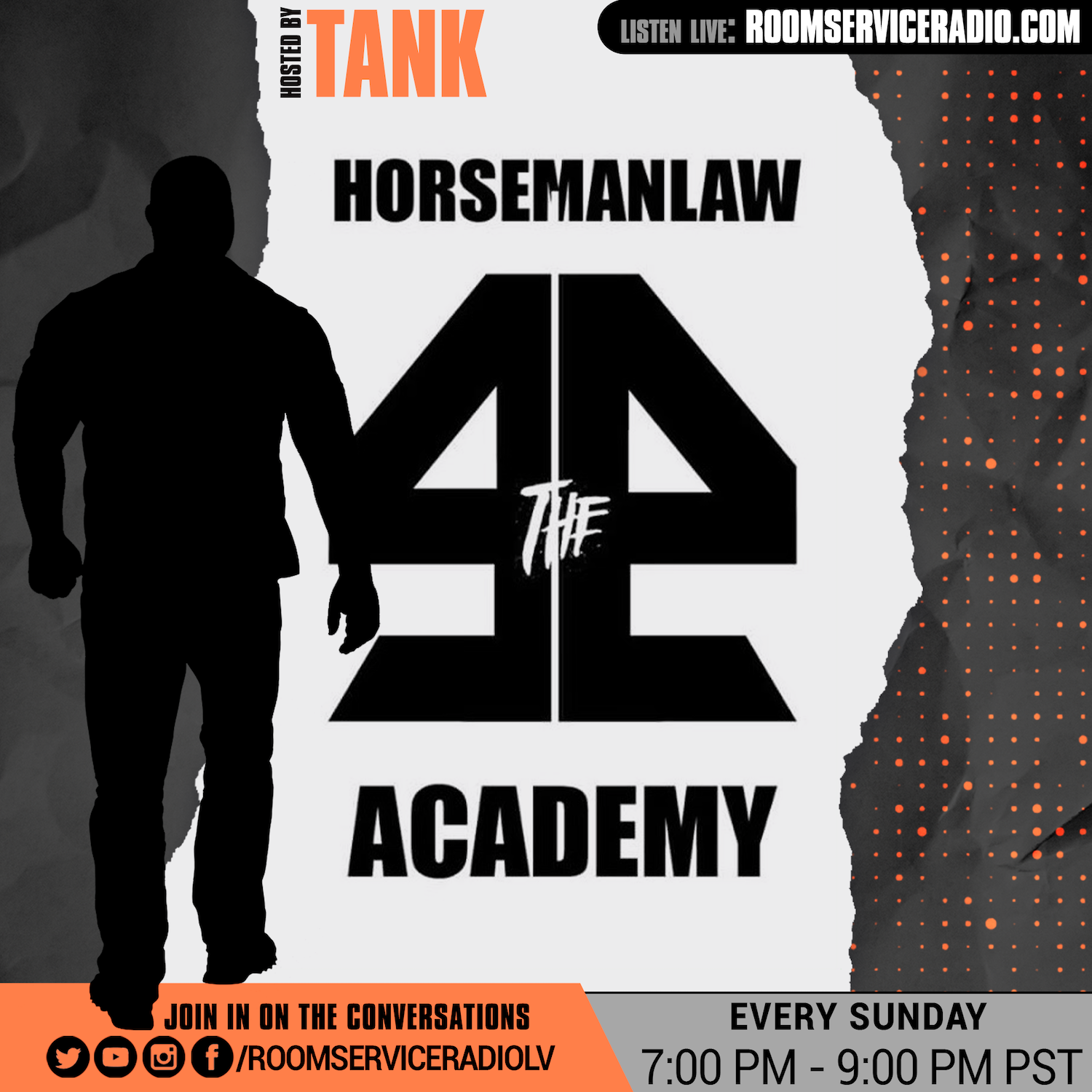
Jae C. Hong / Associated Press
Anaheim Ducks’ Troy Terry, center right, jumps out of the way of the puck as Vegas Golden Knights goaltender Robin Lehner, of Sweden, guards the net during the second period of an NHL hockey game Saturday, April 24, 2021, in Anaheim, Calif.
Saturday, Oct. 9, 2021 | 2 a.m.
If you were tired of seeing only the Avalanche, Blues, Wild, Coyotes, Ducks, Sharks and Kings during the regular season last year, good news.
Only the Ducks, Sharks and Kings will be in the same division as the Golden Knights next season, and there won’t be 24 combined games against them.
The NHL is returning to its traditional division format next year, meaning that along with the California teams, Vegas will be joined in the Pacific Division by three Canadian teams — the Oilers, Flames and Canucks — as well as the expansion Kraken.
The Avalanche, Blues and Wild will return to their usual spots in the Central, while the Coyotes will join them to make room for the Kraken in the Pacific.
It all means Vegas’ path to a division title got a whole lot easier.
The Golden Knights missed out on the West crown (and the President’s Trophy) last year to the Avalanche. And on paper, none of the seven Pacific foes seem to stack up to the Golden Knights, who are expected to be a power once again. They are minus-200 favorites (bet $200 to win $100) at William Hill.
But the games aren’t played on paper. We’ll take a look at Vegas’ divisional rivals and predict which ones could be the biggest threat to the Golden Knights’ third division title in five years.
Teams are sorted alphabetically, with odds to win the division from William Hill.
Anaheim Ducks (plus-7500)
The Ducks have two exciting prospects in forward Trevor Zegras and Jamie Drysdale, an overworked goalie in John Gibson and not much else. They’ve finished sixth or worse in each of the last three seasons and unlike their Southern California neighbors, they are still a few years away from becoming competitive.
There’s little reason to think the Ducks will be much better than last year. Maybe Zegras and Drysdale take the step from good prospect to reliable NHL player, but Anaheim is more than two players away. The Ducks didn’t sign any major free agents, didn’t make any trades and didn’t improve their prospects, even in a weaker Pacific.
It wasn’t that long ago that Anaheim was a playoff fixture. It’s a different time in Orange County now, and it looks like the Ducks are facing another finish near the bottom of the divisional ranks.
Calgary Flames (plus-1500)
The Flames won the Pacific the last time the division completed a full season. But they petered out in the bubble playoffs last year and finished fifth in the North, missing the postseason altogether.
Calgary is an interesting opponent. The core of the team that overwhelmed opposing defenses two years ago is still there, and Blake Coleman was a nice signing to boost the team’s middle six.
A big problem last year was goaltending, as Jacob Markstrom failed to live up to his big contract (a fun aside: Calgary-Vegas games will feature both of Team Sweden’s top two goalies at next year’s Olympics in Markstrom and Robin Lehner).
But if you squint, you can see a dangerous team. Johnny Gaudreau and Matthew Tkachuk are both in contract years, and while the defense doesn’t jump off the page, it’s a solid if unspectacular back end. The key will be Markstrom, and if he returns to his 2019-20 form, the Flames could make a real run at the playoffs.
Edmonton Oilers (plus-450)
The last game the Oilers played in the Pacific Division was an overtime battle with Vegas for first place. They followed that up with a second-place finish in the North last season.
After two straight years coming up one place short in the standings, they’ll be pushing to land on top for the first time since 1992.
The Oilers still have the best high-end talent in the league in the last two league MVPs: Connor McDavid and Leon Draisaitl. Edmonton is always strong with one or both of them on the ice and weak without them.
Zach Hyman was a strong pickup, but Edmonton also brought back 38-year-old Duncan Keith and extended 39-year-old Mike Smith.
McDavid and Draisaitl can only do so much and will need help from the rest of the roster, which on paper looks like one of the better ones in the McDavid era.
The Oilers have always played the Golden Knights tough, with a 5-5-1 all-time record, and Edmonton is the biggest challenge to Vegas winning the division.
The two meet at T-Mobile Arena in Vegas’ fourth game of the season on Oct. 22, then three more times the rest of the year.
Los Angeles Kings (plus-1400)
The Kings were not good last year — they had a 21-28-7 record that tied them for the second-worst mark in the Pacific — but decided this offseason was the time to start building toward a winner.
They traded for Viktor Arvidsson to add some scoring, then signed Phillip Danault to stabilize the top-six, while also ushering in the next wave of forward talent.
And what a wave it is.
Quinton Byfield, Alex Turcotte and Arthur Kaliyev are all on the brink of becoming NHL regulars, ready to graduate from arguably the league’s best farm system.
The knock on the Kings is their defense. Drew Doughty isn’t the Norris Trophy winner of past, and no one else on the blue line has the top-pair pedigree a contending team needs.
There’s a little cap space available if Los Angeles needs a defenseman at the trade deadline, and if the Kings are contending late in the season, you can bet that will be the move they make.
Los Angeles is also in a good spot for the future, with nearly $30 million in projected cap space next summer.
Even if the Kings are not as good as the Golden Knights on paper right now, it won’t be that long before they will be. A first-round rematch from 2018? It’s not out of the question.
San Jose Sharks (plus-2000)
The Sharks are, to be polite, a mess. They tied with the Kings for the second-worst record in the West, just two years removed from an appearance in the Western Conference Final.
Nearly everything that could go wrong for the Sharks has, as seemingly every big-money player has failed to live up to expectations, and the goaltending was so bad that San Jose was willing to eat six years of dead money to buy out Martin Jones.
The one player who did perform well for the Sharks, Evander Kane, is embroiled in off-ice issues that are becoming so toxic that several Sharks players wish he wasn’t there.
San Jose is bringing back basically the same team with some new faces in goal. Two years ago, the rivalry with the Golden Knights looked like it could become one of hockey’s best. But it fizzled to the point where Vegas won all eight games last year as the teams have gone on opposite trajectories.
There’s still a lot of dislike when they share the ice, but it would come as a major surprise if San Jose challenged the Golden Knights for division supremacy.
Seattle Kraken (plus-1200)
After the Golden Knights set the hockey world on fire during their inaugural 2017-18 season, expectations for the Kraken were high heading to the expansion draft.
There was a level of star power available to Seattle that wasn’t there for Vegas, and in what was projected to be a weak Pacific, there was an idea that hockey’s newest team could immediately be one of the top two teams in the division.
Instead, Seattle’s strategy was somewhat puzzling. The Kraken passed on the big-name, high-dollar players like Carey Price or James van Riemsdyk or Max Domi, with the assumption those cap savings would be used on free agents like Gabriel Landeskog or Dougie Hamilton.
An underwhelming expansion draft was followed by signing mid-tier free agents. Coupled with a lack of trades at the draft, it’s hard not to look at Seattle’s roster and feel like the Kraken squandered an opportunity. They could have tried to be really good or accepted being really bad but opted for a strange middle ground.
They still have some impact names.
Jordan Eberle and Yanni Gourde could do some damage up front. The defense, led by former Flames captain Mark Giordano, as well as Jamie Oleksiak and Vince Dunn, will be serviceable. And Philipp Grubauer and Chris Driedger form one of the league’s more impressive goaltending duos.
They also have some cap space to make some moves at the trade deadline.
Besides, we learned four years ago not to underestimate an expansion team. Vegas’ roster wasn’t all that impressive either.
The Kraken will need to outperform expectations to make the race for the Pacific interesting, but it’s still a solid enough squad that it should be in the thick of the postseason fight.
Vancouver Canucks (plus-1400)
A lot has changed in Vancouver since the Golden Knights last saw the Canucks in Game 7 of the 2020 conference semifinals.
Quite simply, things have gone downhill in a hurry for a team that this time last year looked to be cresting into its competitive window.
After a last-place finish in the North Division last year, Vancouver didn’t pack up and start a rebuild but leaned heavy in the opposite direction.
The Canucks augmented their forward group with a legit top-six winger in Conor Garland, then picked up some nice depth pieces while clearing out the bad contracts.
On the blue line, they took the biggest gamble, acquiring Oliver Ekman-Larsson and his massive contract to form one of the league’s most expensive blue lines, along with Tyler Myers and whatever Quinn Hughes eventually signs for.
It’s hard to see a contender out of this group, though, especially because Vancouver doesn’t have the cap space to sign both restricted free agents, Elias Pettersson and Hughes, without moving from the roster elsewhere.
The Golden Knights have always owned the Canucks on the ice. They’ve never lost in regulation (8-0-2 all-time). This doesn’t feel like the year Vancouver turns things around.













